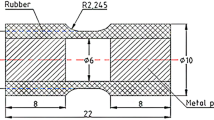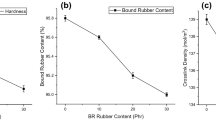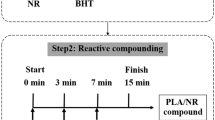Abstract
The abrasion of NR/BR blend vulcanizates has been studied in three different testing machines and the abraded surfaces have been observed in a scanning electron microscope. The ranking of the unfilled blends obtained from Akron abrader is different from that obtained from Du Pont and DIN abraders, while in the case of the black-filled vulcanizates the same ranking can be obtained from all the three machines. Tensile and fatigue properties are believed to play major roles in determining abrasion loss in the Akron abrader, while the effect of friction is more pronounced in the other two machines. The slip angle of 20° and the deformation of the surface layer of rubber during abrasion accounts for the difference in the direction of the abrasion pattern observed in the case of Akron abrader. The carbon black-reinforced vulcanizates give rise to a fine abrasion pattern. Because of the continuous change in the direction of abrasion in DIN abrader, a well-defined pattern was not observed. The very low abrasion loss of 50/50 blend vulcanizates in Du Pont abrader is also evident from the nature of the abraded surface.
Similar content being viewed by others
References
A. Schallamach,Trans. Inst. Rubber Ind. 28 (1952) 256.
Idem, Proc. Phys. Soc. B 67 (1954) 883.
Idem, Wear 17 (1971) 301.
Idem, Rubber Chem. Technol. 41 (1968) 209.
M. M. Reznikovskii andG. I. Brodskii, in “Abrasion of Rubber”, edited by D. I. James (Maclaren, London, 1967) p. 14.
G. I. Brodskii andM. M. Reznikovskii,ibid.“ p. 81.
M. M. Reznikovskii,ibid.“ p. 119.
E. Southern andA. G. Thomas,Rubber Chem. Technol. 52 (1979) 1008.
K. Satake, T. Some, M. Hamada andK. Hayakawa,ibid. 44 (1971) 1173.
W. M. Saltman, in “Encyclopedia of Polymer Science and Technology”, Vol. 2, edited by H. F. Mark, N. G. Gaylord and N. M. Bikales (Interscience, New York, 1965) p. 678.
A. K. Bhowmick, S. Basu andS. K. De,J. Mater. Sci. 16 (1981) 1654.
Idem, Rubber Chem. Technol. 53 (1980) 321.
A. K. Bhowmick, G. B. Nando, S. Basu andS. K. De,ibid. 53 (1980) 327.
N. M. Mathew, A. K. Bhowmick andS. K. De,ibid. 55 (1982) 51.
S. K. Chakraborty, A. K. Bhowmick, B. K. Dhindaw andS. K. De,ibid. 55 (1982) 41.
N. M. Mathew andS. K. De,Polymer 23 (1982) 632.
N. M. Mathew, A. K. Bhowmick, B. K. Dhindaw andS. K. De,J. Mater. Sci. in press.
R. Mukhopadhyay, S. K. De andS. N. Chakraborty,Polymer 18 (1977) 1243.
A. Schallamach,J. Appl. Polymer Sci. 12 (1968) 281.
K. A. Grosch andA. Schallamach,Rubber Chem. Technol. 49 (1976) 862.
Author information
Authors and Affiliations
Rights and permissions
About this article
Cite this article
Mathew, N.M., De, S.K. Scanning electron microscopy studies in abrasion of NR/BR blends under different test conditions. J Mater Sci 18, 515–524 (1983). https://doi.org/10.1007/BF00560641
Received:
Accepted:
Issue Date:
DOI: https://doi.org/10.1007/BF00560641




